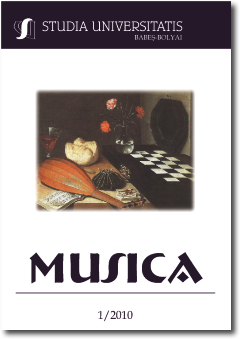THE EXAMPLES OF AXIS - ORDER FUNCTIONAL THINKING IN THE WORKS OF ZOLTÁN KODÁLY
Keywords:
axis-order, functional sequences, Zoltán Kodály, Ernő Lendvai, Lajos Bárdos, relative sol-fa, harmonics, heptatonia secunda (second seven-tone system), modal dominant, Kodály-dominant or Neapolitan-dominant, median dominant, dominant-axis, implied dominant, polar distanceAbstract
The functional axis-order in Bartók’s works, as the final consequence of the tempered ton system was discovered by Ernő Lendvai from the fifties of the twentieth century. We can find the axis-order functional thinking in the works of Zoltán Kodály, as an important element of his personal style, but that is mostly undiscovered, especially in connection with the Hungarian folksongs. The study Heptatonia secunda by Lajos Bárdos gives new ideas and tools for the analysis of Kodály’s oeuvre.
Several characteristic examples are collected in this article from songs, choral works and instrumental music by Kodály to prove that idea, and, looking for the origin of the axis-order it shows its somehow earlier appearance in the music of Vivaldi, Haendel and Mozart.
References
Bárdos, Lajos, Elemző írások a zenéről (Analytical Writings about the Music), Cherokee Kft., 1994.
Bárdos, Lajos, Írások népzenénkről (Writings about our Folk Music), Tankönyvkiadó, Budapest, 1988.
Bárdos, Lajos, Heptatonia secunda, in: Harminc írás (Thirthy Writings), Zeneműkiadó, Budapest, 1969, p. 348.
Bárdos, Lajos, Tíz újabb írás (Ten recently Writing), Zeneműkiadó, Budapest, 1974.
Lendvai, Ernő, Bartók és Kodály harmóniavilága (The Harmony World of Bartók and Kodály), Zeneműkiadó, Budapest 1975.
Lendvai, Ernő, Bartók stílusa (Bartók’s Style), Editio Musica, Budapest, 1955 and Ed. Akkord, Budapest, 1993.
Downloads
Published
How to Cite
Issue
Section
License
Copyright (c) 2010 Studia Universitatis Babeș-Bolyai Musica

This work is licensed under a Creative Commons Attribution-NonCommercial-NoDerivatives 4.0 International License.



